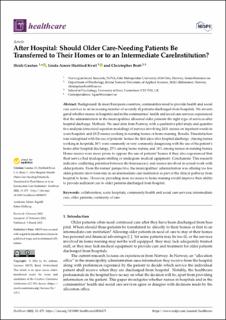After Hospital: Should Older Care-Needing Patients Be Transferred to Their Homes or to an intermediate Care Institution?
Peer reviewed, Journal article
Published version
Permanent lenke
https://hdl.handle.net/11250/3029752Utgivelsesdato
2022Metadata
Vis full innførselSamlinger
Originalversjon
10.3390/healthcare10030475Sammendrag
In most European countries, communities need to provide health and socialcare services to an increasing number of severely ill patients discharged from hospitals. We investi-gated whether nurses in hospitals and in the communities’ health and social care services experiencedthat the administration in the municipalities allocated older patients the right type of services afterhospital discharge. Methods: We used data from Norway, with a qualitative pilot study and quantita-tive analysis (structural equation modeling) of surveys involving 2431 nurses on inpatient wards inacute hospitals and 4312 nurses working in nursing homes or home nursing. Results: Dissatisfactionwas widespread with the use of patients’ homes the first days after hospital discharge. Among nursesworking in hospitals, 38% were commonly or very commonly disagreeing with the use of the patient’shome after hospital discharge, 25% among home nurses, and 18% among nurses in nursing homes.Home nurses were more prone to oppose the use of patients’ homes if they also experienced thattheir service had inadequate staffing or inadequate medical equipment. Conclusions: This researchindicates conflicting priorities between the bureaucracy and nurses involved in actual work witholder patients. From the nurses’ perspective, the municipalities’ administration was offering too fewolder patients short-term-stay in an intermediate care institution as part of the clinical pathway fromhospital to home. However, providing more recourses to home nursing would improve their abilityto provide sufficient care to older patients discharged from hospital.

